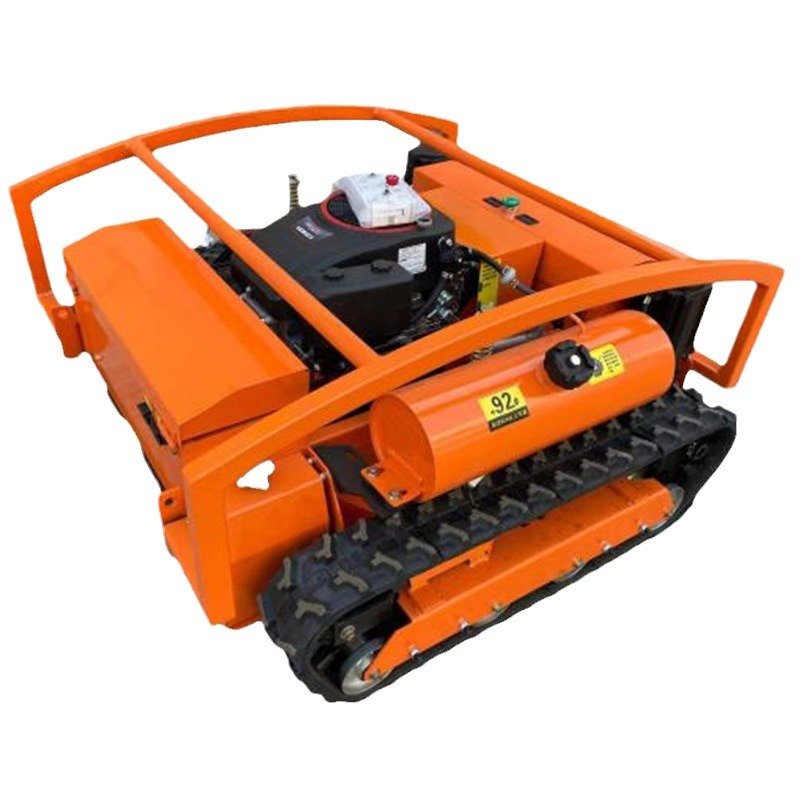

In today's rapidly advancing technological era, the agricultural sector is undergoing an intelligent transformation, and remote-controlled lawn mowers are emerging as a powerful force in this change. With their unique advantages and broad application prospects, these devices are gradually becoming an essential tool for agricultural production.
Remote-controlled lawn mowers offer numerous significant advantages in the agricultural field. First and foremost, their safety is unparalleled. Traditional lawn mowers pose a high risk to operators, who must work in close proximity to the machine, especially the fast-rotating blades. In contrast, remote-controlled lawn mowers allow operators to control the machine from a distance, avoiding direct contact with the blades and significantly reducing the risk of injury.
Moreover, remote-controlled lawn mowers demonstrate exceptional adaptability to complex terrains. Many agricultural lands have challenging topographies, such as slopes, hills, orchards, and vineyards, where traditional mowers struggle to operate effectively. However, remote-controlled mowers, with their flexible maneuverability and compact design, can easily navigate these difficult terrains and perform efficiently. For example, some models of remote-controlled lawn mowers can operate stably on slopes as steep as 55 degrees, covering up to 3,000 square meters per hour, greatly improving operational efficiency.
Additionally, remote-controlled lawn mowers are highly intelligent. Equipped with advanced sensors and navigation systems, these devices can achieve automatic obstacle avoidance, precise cutting, and path planning. Operators can easily control the mower's start, stop, direction, and cutting height using a smartphone app or remote control. Some models even allow for pre-setting operational times and routes, enabling fully automated operation. This level of intelligent control not only saves labor costs but also enhances the precision and uniformity of the cutting process.
Remote-controlled lawn mowers have a wide range of applications in the agricultural sector, covering almost all scenarios that require grass cutting. In large farms and pastures, these devices can quickly clear vast areas of grass, maintaining the tidiness of the pastures and providing a better grazing environment for livestock. In orchards and vineyards, their compact and flexible design allows them to easily move between fruit trees and grapevines without causing damage to the crops while effectively removing weeds and reducing the potential for pest and disease infestations.
In tea gardens, remote-controlled lawn mowers can precisely control the cutting height, maintaining a clean environment for tea tree growth while avoiding damage to the root systems. Additionally, in solar farms, these devices can easily access the area beneath solar panels to perform grass-cutting operations, ensuring that the panels are not shaded by weeds and maximizing solar power generation efficiency.
Beyond agriculture, remote-controlled lawn mowers also excel in urban landscaping and private gardens. They can be used for lawn maintenance in parks, green spaces, golf courses, and private courtyards, enhancing the aesthetics and comfort of urban and domestic environments.
The global market for remote-controlled lawn mowers is experiencing rapid growth. According to market research firms, the market is expected to grow at an annual compound rate of approximately 10%, with a projected market size of over 7 billion US dollars by 2030. This growth trend is driven by several key factors:
Firstly, technological advancements are driving improvements in the performance and cost reduction of remote-controlled lawn mowers. With the development of sensor technology, navigation systems, and battery technology, these devices are becoming more intelligent and have longer battery life, making them better suited to meet the needs of agricultural and landscaping operations.
Secondly, the increasing environmental awareness is also fueling the demand for electric lawn mowers. Traditional fuel-powered mowers produce significant exhaust and noise pollution during operation, while electric remote-controlled mowers generate almost no carbon emissions and produce less noise, aligning with modern society's environmental requirements.
Moreover, the labor shortage issue is another important factor driving the growth of the remote-controlled lawn mower market. In many countries and regions, the cost of agricultural labor is rising, and labor resources are scarce. Remote-controlled lawn mowers, which not only improve operational efficiency but also reduce labor dependence, have become an effective solution for agricultural producers to address labor shortages.
With their high efficiency, safety, and intelligence, remote-controlled lawn mowers are becoming an essential tool in the agricultural and landscaping sectors. They can effectively handle grass-cutting tasks in complex terrains and large areas while reducing labor input through intelligent operations, improving operational efficiency, and quality. As technology continues to advance and the market expands, remote-controlled lawn mowers are expected to play a more significant role in the future, bringing more convenience and benefits to agricultural producers. In the global trend towards intelligent and efficient agriculture, remote-controlled lawn mowers are undoubtedly an important force driving this transformation.